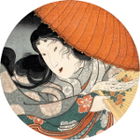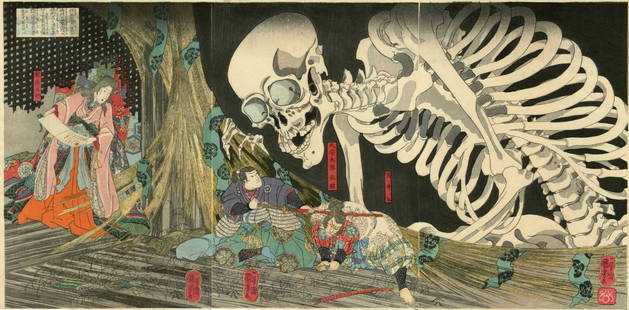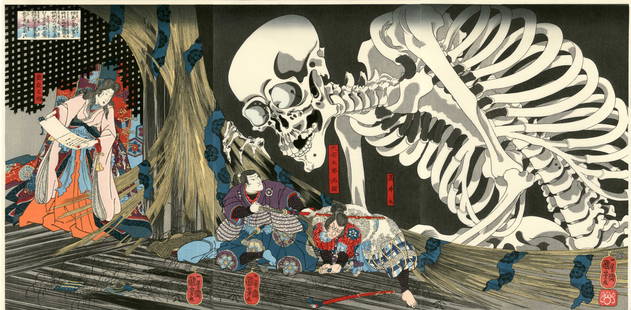
Yoshitoshi: Flute Player Moonlight Woodblock Triptych
Tsukioka Yoshitoshi Sale History
View Price Results for Tsukioka YoshitoshiRelated Prints & Multiples
More Items from Tsukioka Yoshitoshi
View MoreRecommended Art
View More






Item Details
Description
Japanese Woodblock Triptych, 1883, this Showa Era edition prublished from recarved blocks, extremely rare in any edition.
SIZE IN INCHES: oban triptych, 27.75 x 14 inches
COMMENTS: Indisputedly Yoshitoshi's masterpiece, and considered among of the greatest woodblock designs of all time. "Sold out" at publisher. Rarely seen.
TSUKIOKA YOSHITOSHI (1839-1892), as he is now most often known, was born in old Edo, in 1839; he was originally named Owariya Yonejiro. His father, Owariya Kinzaburo (1815-1863) was a well-off merchant; his mother is unknown, but she and Yoshitoshi’s father may have divorced when he was young. Yoshitoshi’s grandfather (Yoshioka Hyobu, as he came to be named, 1796-1855) bought his way into samurai status, so at that point the entire family took the name Yoshioka.
In 1850, at the age of 11, he was apprenticed to Kuniyoshi, one of great masters of Japanese woodblock prints; he was given the art name Yoshitoshi by his master, Kuniyoshi. Although he was not seen as Kuniyoshi’s successor in his lifetime, he is now recognized as the chief pupil of Kuniyoshi. Yoshitoshi’s first print appeared in 1853, but nothing else appeared for quite some time, perhaps as a result of the illness of his master Kuniyoshi during his last years. Although his life was hard after Kuniyoshi's death in 1861, he did manage to produce some work, 44 prints of his being known from 1862. In 1865 he started to use the alternative family name Tsukioka, although he retained Yoshioka as his legal family name (and in fact was buried under the name Yoshioka Taiso Yoshitoshi). Apparently, this name was the family name used by a noted Osaka painter, Tsukioka Settei (1710-1786), who was a distant relative, and Yoshitoshi seems to have believed that he was his artistic heir.
Yoshitoshi’s early work is full of extremely graphic violence and death, perhaps mirroring the lawlessness and violence of the Japan around him, which was simultaneously going through the breakdown of the feudal system imposed by the Tokugawa shoguns, as well as the impact of the West. During this period his fame grew, and by 1869 he was regarded as one of the best woodblock artists in Japan.
Shortly thereafter, he ceased to receive commissions, perhaps because the public were tired of scenes of violence. By 1871, he became severely depressed, and his personal life became one of great turmoil, which was to continue sporadically until his death. He lived in appalling conditions with his devoted mistress, Okoto, who sold off her clothes and possessions to support him. At one point they were reduced to burning the floor-boards from the house for warmth.
His fortunes started to turn by 1873, when his mood improved, and he started to produce more prints. Before that year, he had signed most of his prints as “Ikkaisai Yoshitoshi”, perhaps in honor of the name his master Kuniyoshi had used, “Ichiyusai”. Perhaps to commemorate his resurgence, from then on he changed the first part of the name to “Taiso” (meaning 'great resurrection').
Newspapers sprung up in the modernization drive, and Yoshitoshi was hired to produced prints for one. His financial condition was still precarious, though, and in 1876, his mistress Okoto, in a gesture of devotion which is typically Japanese, but hard for us to understand, sold herself to a brothel to help him. With the Satsuma Rebellion of 1877, in which the old feudal order made one last attempt to stop the new Japan, newspaper circulation soared, and woodblock artists were in demand, with Yoshitoshi most of all. The prints he did gave him public recognition, and the money was a help, but it was not until 1882 that he was secure.
In late 1877, he took up with a new mistress, the geisha Oraku; like Okotu, she sold her clothes and possessions to support him, and when they separated after a year, she too hired herself out to a brothel. By this point, the woodblock industry was in severe straits. All the great woodblock artists of the early part of the century, Hiroshige, Kunisada, and Kuniyoshi, had all died, and the woodblock print as an art form was dying in the confusion of modernizing Japan. Yoshitoshi insisted on high standards of production and helped save it temporarily from degeneracy.
In 1880, he met another woman, a former Geisha with two children, Sakamaki Taiko. They were married in 1884, and while he continued to philander, her gentle and patient manner seems to have helped stabilize him. His last years were among his most productive, with his great series “One Hundred Aspects of the Moon” (1885-1892), and “New Forms of Thirty-Six Ghosts” (often called simply “Thirty-Six Ghosts”) (1889-1892), as well as some masterful triptychs of kabuki theatre actors and scenes. During this period he also cooperated with his friend, the actor Danjuro, and others, in an attempt to save some of the traditional Japanese arts.
In his last years, his mental problems started to recur. In early 1891 he invited friends to a gathering of artists that turned out to be a delusion. After more symptoms, he was admitted to mental hospital. He eventually left, in May 1892, but did not return home, instead renting rooms. He died there three weeks later, on June 9, 1892, from a cerebral hemorrhage. He was only 53 years old.
SIZE IN INCHES: oban triptych, 27.75 x 14 inches
COMMENTS: Indisputedly Yoshitoshi's masterpiece, and considered among of the greatest woodblock designs of all time. "Sold out" at publisher. Rarely seen.
TSUKIOKA YOSHITOSHI (1839-1892), as he is now most often known, was born in old Edo, in 1839; he was originally named Owariya Yonejiro. His father, Owariya Kinzaburo (1815-1863) was a well-off merchant; his mother is unknown, but she and Yoshitoshi’s father may have divorced when he was young. Yoshitoshi’s grandfather (Yoshioka Hyobu, as he came to be named, 1796-1855) bought his way into samurai status, so at that point the entire family took the name Yoshioka.
In 1850, at the age of 11, he was apprenticed to Kuniyoshi, one of great masters of Japanese woodblock prints; he was given the art name Yoshitoshi by his master, Kuniyoshi. Although he was not seen as Kuniyoshi’s successor in his lifetime, he is now recognized as the chief pupil of Kuniyoshi. Yoshitoshi’s first print appeared in 1853, but nothing else appeared for quite some time, perhaps as a result of the illness of his master Kuniyoshi during his last years. Although his life was hard after Kuniyoshi's death in 1861, he did manage to produce some work, 44 prints of his being known from 1862. In 1865 he started to use the alternative family name Tsukioka, although he retained Yoshioka as his legal family name (and in fact was buried under the name Yoshioka Taiso Yoshitoshi). Apparently, this name was the family name used by a noted Osaka painter, Tsukioka Settei (1710-1786), who was a distant relative, and Yoshitoshi seems to have believed that he was his artistic heir.
Yoshitoshi’s early work is full of extremely graphic violence and death, perhaps mirroring the lawlessness and violence of the Japan around him, which was simultaneously going through the breakdown of the feudal system imposed by the Tokugawa shoguns, as well as the impact of the West. During this period his fame grew, and by 1869 he was regarded as one of the best woodblock artists in Japan.
Shortly thereafter, he ceased to receive commissions, perhaps because the public were tired of scenes of violence. By 1871, he became severely depressed, and his personal life became one of great turmoil, which was to continue sporadically until his death. He lived in appalling conditions with his devoted mistress, Okoto, who sold off her clothes and possessions to support him. At one point they were reduced to burning the floor-boards from the house for warmth.
His fortunes started to turn by 1873, when his mood improved, and he started to produce more prints. Before that year, he had signed most of his prints as “Ikkaisai Yoshitoshi”, perhaps in honor of the name his master Kuniyoshi had used, “Ichiyusai”. Perhaps to commemorate his resurgence, from then on he changed the first part of the name to “Taiso” (meaning 'great resurrection').
Newspapers sprung up in the modernization drive, and Yoshitoshi was hired to produced prints for one. His financial condition was still precarious, though, and in 1876, his mistress Okoto, in a gesture of devotion which is typically Japanese, but hard for us to understand, sold herself to a brothel to help him. With the Satsuma Rebellion of 1877, in which the old feudal order made one last attempt to stop the new Japan, newspaper circulation soared, and woodblock artists were in demand, with Yoshitoshi most of all. The prints he did gave him public recognition, and the money was a help, but it was not until 1882 that he was secure.
In late 1877, he took up with a new mistress, the geisha Oraku; like Okotu, she sold her clothes and possessions to support him, and when they separated after a year, she too hired herself out to a brothel. By this point, the woodblock industry was in severe straits. All the great woodblock artists of the early part of the century, Hiroshige, Kunisada, and Kuniyoshi, had all died, and the woodblock print as an art form was dying in the confusion of modernizing Japan. Yoshitoshi insisted on high standards of production and helped save it temporarily from degeneracy.
In 1880, he met another woman, a former Geisha with two children, Sakamaki Taiko. They were married in 1884, and while he continued to philander, her gentle and patient manner seems to have helped stabilize him. His last years were among his most productive, with his great series “One Hundred Aspects of the Moon” (1885-1892), and “New Forms of Thirty-Six Ghosts” (often called simply “Thirty-Six Ghosts”) (1889-1892), as well as some masterful triptychs of kabuki theatre actors and scenes. During this period he also cooperated with his friend, the actor Danjuro, and others, in an attempt to save some of the traditional Japanese arts.
In his last years, his mental problems started to recur. In early 1891 he invited friends to a gathering of artists that turned out to be a delusion. After more symptoms, he was admitted to mental hospital. He eventually left, in May 1892, but did not return home, instead renting rooms. He died there three weeks later, on June 9, 1892, from a cerebral hemorrhage. He was only 53 years old.
Condition
Fine, no flaws
Buyer's Premium
- 15% up to $10,000.00
- 15% up to $20,000.00
- 15% above $20,000.00
Yoshitoshi: Flute Player Moonlight Woodblock Triptych
Estimate $3,000 - $4,000
22 bidders are watching this item.
Shipping & Pickup Options
Item located in Augusta, GA, us$35 shipping in the US
Payment
Accepts seamless payments through LiveAuctioneers

TOP
































































